Morphological Configuration of Sensory Biomedical Receptors Based on Structures Integrated by Electric Circuits and Utilizing Magnetic-Responsive Hybrid Fluid (HF)
Abstract
1. Introduction
2. Materials
2.1. Five Senses and Receptors
2.2. HF Rubber
2.3. Electrolytic Polymerization
- solidification
- creation of built-in voltage
- production of porous rubber, and infiltration with a liquid
- adhesion a rubber to metal
2.4. Artificial Receptors
2.4.1. Fabrication
2.4.2. Equivalent Electric Circuit
3. Experimental Procedure
3.1. Mechanical Response
3.2. Thermal Response
3.3. Vibration Response
3.4. Acoustic Response
3.5. Gustatory Response
3.6. Olfactory Response
4. Results and Discussion
4.1. Mechanical Response
4.2. Thermal Response
4.3. Vibration Response
4.4. Acoustic Response
4.5. Acoustic Response
4.6. Olfactory Response
4.7. Gustatory Response
4.8. Consequence
5. Conclusions
Funding
Institutional Review Board Statement
Informed Consent Statement
Data Availability Statement
Acknowledgments
Conflicts of Interest
Appendix A







Appendix B
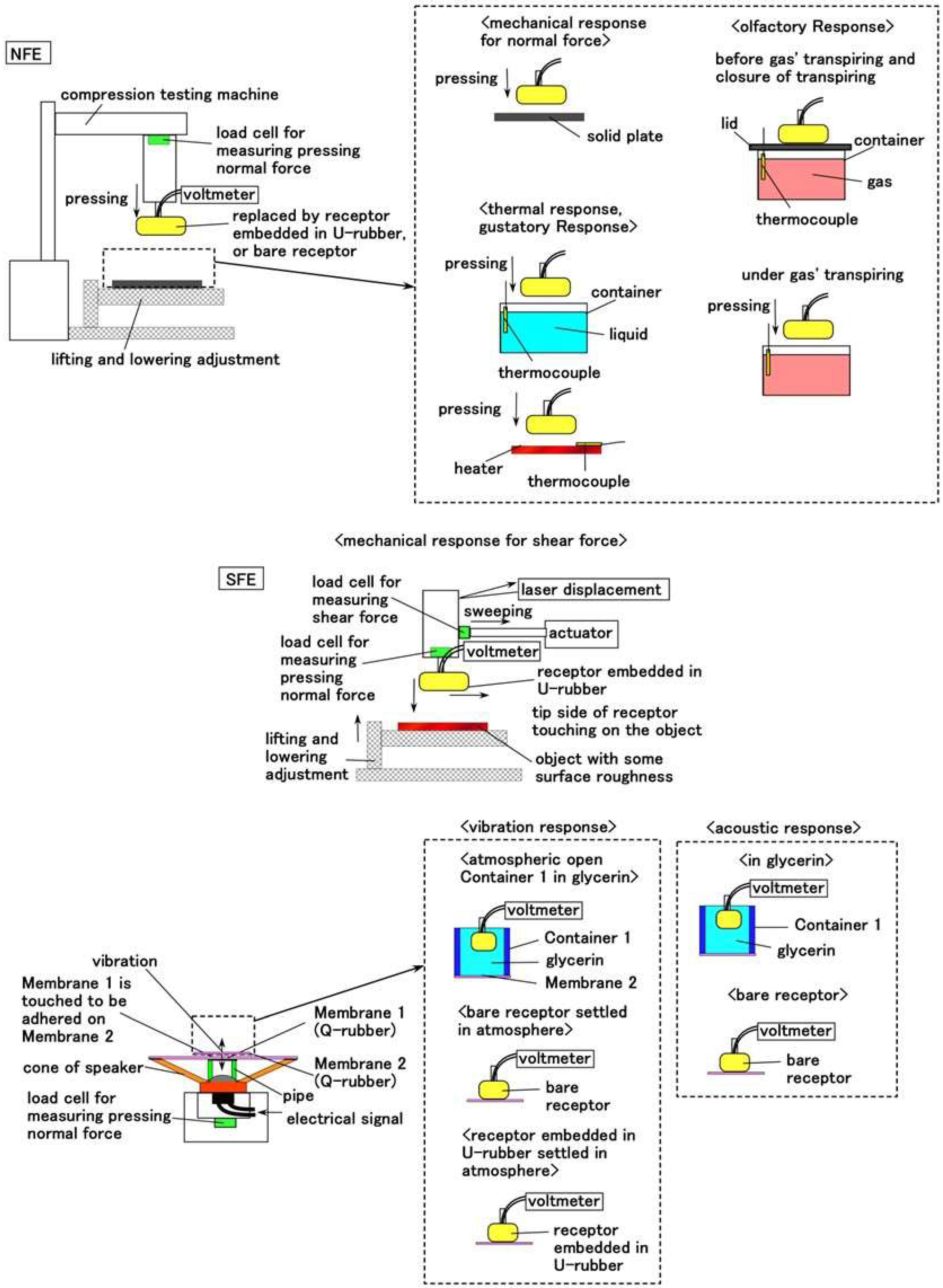
Appendix C
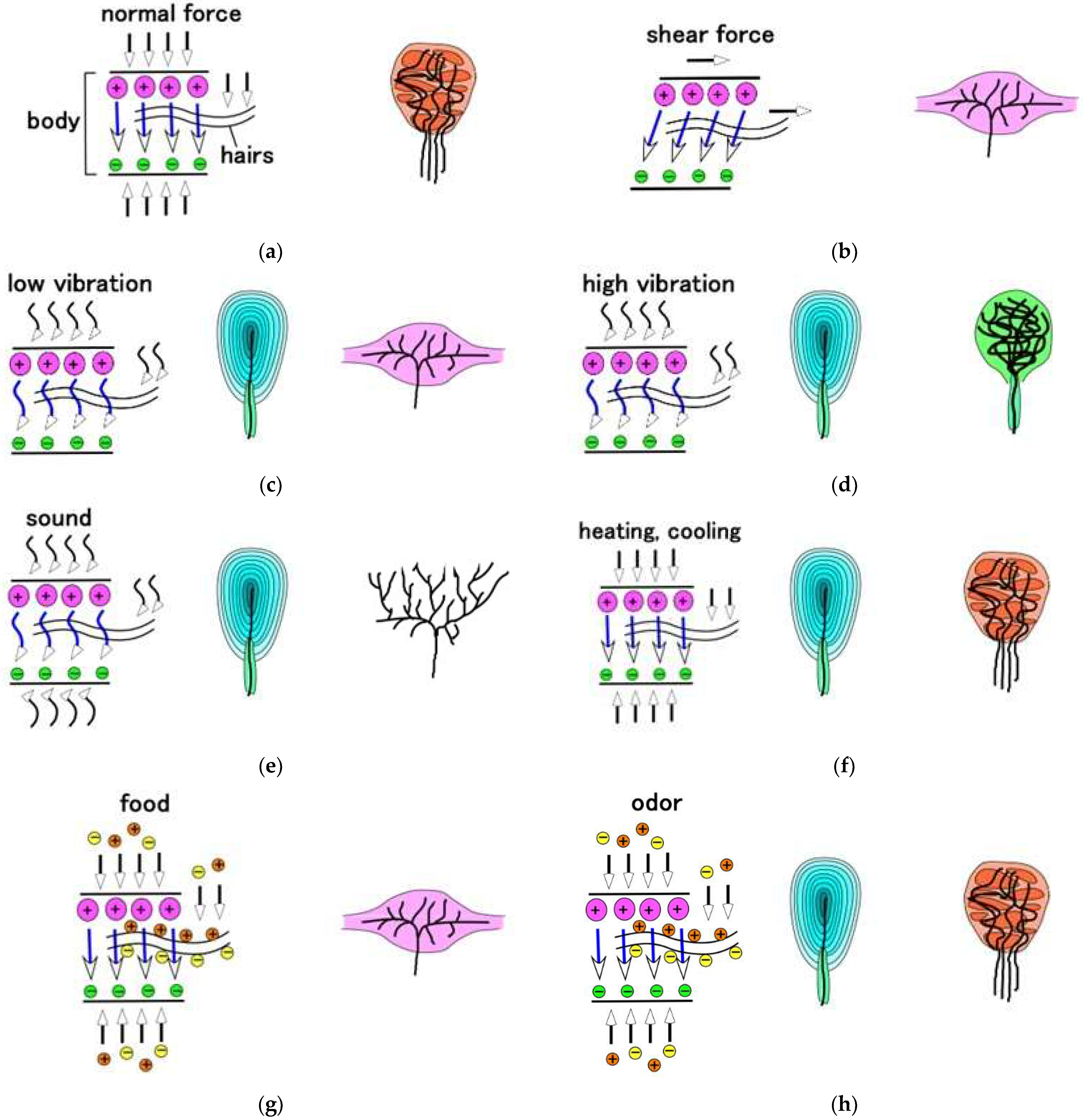
References
- Urhal, P.; Weightman, A.; Diver, C.; Bartolo, P. Robot assisted additive manufacturing: A review. Robot. Comput. Integrat. Manuf. 2019, 59, 335–345. [Google Scholar] [CrossRef]
- Yang, G.Z.; Bellingham, J.; Dupont, P.E.; Fischer, P.; Floridi, L.; Full, R.; Jacobstein, N.; Kumar, V.; McNutt, M.; Merrifield, R.; et al. The grand challenges of science robotics. Sci. Robot. 2018, 3, eaar7650. [Google Scholar] [CrossRef] [PubMed]
- Luan, H.; Zhang, Y. Programmable stimulation and actuation in flexible and stretchable electronics. Adv. Intell. Syst. 2021, 3, 2000228. [Google Scholar] [CrossRef]
- Ji, X.; Zhao, X.; Tan, M.C.; Zhao, R. Artificial perception built on memristive system: Visual, auditory, and tactile sensations. Adv. Intell. Syst. 2020, 2, 1900118. [Google Scholar] [CrossRef]
- Svechtarova, M.I.; Buzzacchera, I.; Tobes, B.J.; Lauko, J.; Anton, N.; Wilson, C.J. Sensor devices inspired by the five sensors: A review. Electroanalysis 2016, 28, 1201–1241. [Google Scholar] [CrossRef]
- Chadha, U.; Bhardwaj, P.; Agarwal, R.; Rawat, P.; Agarwal, R.; Gupta, I.; Panjwani, M.; Singh, S.; Ahuja, C.; Selvaraj, S.K.; et al. Recent progress and growth in biosensors technology: A critical review. J. Ind. Eng. Chem. 2022, 109, 21–51. [Google Scholar] [CrossRef]
- Yang, J.C.; Mun, J.; Kwon, S.Y.; Park, S.; Bao, Z.; Park, S. Electronic skin: Recent progress and future prospects for skin-attachable devices for health monitoring, robotics, and prosthetics. Adv. Mater. 2019, 31, 1904765. [Google Scholar] [CrossRef]
- Chortos, A.; Liu, J.; Bao, Z. Pursuing prosthetic electronic skin. Nat. Mater. 2016, 15, 937–950. [Google Scholar] [CrossRef] [PubMed]
- Tanaka, M.; Leveque, J.L.; Tagami, H.; Kikuchi, K.; Chonan, S. The “haptic finger”—A new device for monitoring skin condition. Ski. Res. Technol. 2003, 9, 131–136. [Google Scholar] [CrossRef]
- Hua, Q.; Sun, J.; Liu, H.; Bao, R.; Yu, R.; Zhai, J.; Pan, C.; Wang, Z.L. Skin-inspired highly stretchable and conformable matrix networks for multifunctional sensing. Nat. Commun. 2018, 9, 244. [Google Scholar] [CrossRef]
- Lee, H.S.; Chung, J.; Hwang, G.T.; Jeong, C.K.; Jung, Y.; Kwak, J.H.; Kang, H.; Byun, M.; Kim, W.D.; Hur, S.; et al. Flexible inorganic piezoelectric acoustic nanosensors for biomimetic artificial hair cells. Adv. Funct. Mater. 2014, 24, 6914–6921. [Google Scholar] [CrossRef]
- Inaoka, T.; Shintaku, H.; Nakagawa, T.; Kawano, S.; Ogita, H.; Sakamoto, T.; Hamanishi, S.; Wada, H.; Ito, J. Piezoelectric materials mimic the function of the cochlear sensory epithelium. Proc. Natl. Acad. Sci. USA 2011, 108, 18390–18395. [Google Scholar] [CrossRef] [PubMed]
- Raoufi, M.A.; Moshizi, S.A.; Razmjou, A.; Wu, S.; Ebrahimi Warkiani, M.E.; Asadnia, M. Development of a biomimetic semicircular canal with MEMS sensors to restore balance. IEEE Sens. J. 2019, 19, 11675–11686. [Google Scholar] [CrossRef]
- Moshizi, S.; Azadi, S.; Belford, A.; Razmjou, A.; Wu, S.; Han, Z.J.; Asadnia, M. Development of an ultra-sensitive and flexible piezoresistive flow sensor using vertical graphene nanosheets. Nano. Micro Lett. 2020, 12, 109. [Google Scholar] [CrossRef] [PubMed]
- Zhao, T.; Wang, Q.; Du, A. Self-powered flexible sour sensor for detecting ascorbic acid concentration based on triboelectrification/enzymatic-reaction coupling effect. Sensors 2021, 21, 373. [Google Scholar] [CrossRef]
- Zhang, N.; Wei, X.; Fan, Y.; Zhou, X.; Liu, Y. Recent advances in development of biosensors for taste-related analyses. TrAC Trends Anal. Chem. 2020, 129, 115925. [Google Scholar] [CrossRef]
- Baldwin, E.A.; Bai, J.; Plotto, A.; Dea, S. Electronic noses and tongues: Applications for the food and pharmaceutical industries. Sensors 2011, 11, 4744–4766. [Google Scholar] [CrossRef]
- Kim, C.; Lee, K.K.; Kang, M.S.; Shin, D.M.; Oh, J.W.; Lee, C.S.; Han, D.W. Artificial olfactory sensor technology that mimics the olfactory mechanism: A comprehensive review. Biomater. Res. 2022, 26, 40. [Google Scholar] [CrossRef]
- Cheng, L.; Meng, Q.H.; Lilienthal, A.J.; Qi, P.F. Development of compact electronic noses: A review. Meas. Sci. Technol. 2021, 32, 062002. [Google Scholar] [CrossRef]
- Covington, J.A.; Marco, S.; Persaud, K.C.; Schiffman, A.S.; Nagle, H.T. Artificial olfaction in the 21st century. IEEE Sens. J. 2021, 21, 12969–12990. [Google Scholar] [CrossRef]
- Munger, B.L.; Ide, C. The structure and function of cutaneous sensory receptors. Arch. Histol. Cytol. 1988, 51, 1–34. [Google Scholar] [CrossRef] [PubMed]
- Leite, J.G.S.; Cavalcante, M.L.C.; Jamacaru, F.V.F.; Pompeu, M.M.L.; Leite, J.A.D.; Coelho, D.M.N.; Freitas, M.R. Morphology of nerve endings in vocal fold of human newborn. Int. J. Pediatr. Orl. 2016, 89, 55–59. [Google Scholar]
- Figols, J.; Hanuschik, W.; Cervós-Navarro, J.C. Krause’s end-bulb microtumor of the conjunctiva: Optic and ultrastructural description of a case. Graefe’s Arch. Clin. Exp. Ophthalmol. 1992, 230, 206–212. [Google Scholar] [CrossRef] [PubMed]
- Chang, W.; Kanda, H.; Ikeda, R.; Ling, J.; DeBerry, J.J.; Gu, J.G. Merkel disk is a serotonergic synapse in the epidermis for transmitting tactile signals in mammals. Proc. Natl. Acad. Sci. USA 2016, 29, E5491–E5500. [Google Scholar]
- Neubarth, N.L.; Emanuel, A.J.; Liu, Y.; Springel, M.W.; Handler, A.; Zhang, Q.; Lehnert, B.P.; Guo, C.; Orefice, L.L.; Abdelaziz, A.; et al. Meissner corpuscles and their spatially intermingled afferents underlie gentle touch perception. Science 2020, 368, 1330. [Google Scholar] [CrossRef] [PubMed]
- Wakisaka, S.; Atsumi, Y.; Youn, S.H.; Maeda, T. Morphological and cytochemical characteristics of periodontal Ruffini ending under normal and regeneration processes. Arch. Histol. Cytol. 2000, 63, 91–113. [Google Scholar] [CrossRef]
- Feito, J.; Suarez, O.G.; Piqueras, J.G.; Mesa, Y.G.; Sanchez, A.P.; Suazo, I.; Cabo, R.; Quintanilla, J.S.; Cobo, J.; Vega, J.A. The development of human digital Meissner’s and Pacinian corpuscles. Ann. Anat.-Anat. Anz. 2018, 219, 8–24. [Google Scholar] [CrossRef]
- Shimada, K.; Saga, N. Development of a hybrid piezo natural rubber piezoelectricity and piezoresistivity sensor with magnetic clusters made by electric and magnetic field assistance and filling with magnetic compound fluid. Sensors 2017, 17, 346. [Google Scholar] [CrossRef]
- Shimada, K.; Ikeda, R.; Kikura, H.; Takahashi, H. Development of novel magnetic responsive intelligent fluid, hybrid fluid (HF), for production of soft and tactile rubber. World J. Mech. 2021, 11, 187–203. [Google Scholar] [CrossRef]
- Shimada, K.; Ikeda, R.; Kikura, H.; Takahashi, H. Morphological fabrication of rubber cutaneous receptors embedded in a stretchable skin-mimicking human tissue by the utilization of hybrid fluid. Sensors 2021, 21, 6834. [Google Scholar] [CrossRef]
- Shimada, K.; Ikeda, R.; Kikura, H.; Takahashi, H. Enhancement of diversity in production and application utilizing electrolytically polymerized rubber sensors with MCF: 1st report on consummate fabrication combining varied kinds of constituents with porous permeant stocking-like rubber. Sensors 2020, 20, 4658. [Google Scholar] [CrossRef] [PubMed]
- Shimada, K. Enhancement of MCF rubber utilizing electric and magnetic fields, and clarification of electrolytic polymerization. Sensors 2017, 17, 767. [Google Scholar] [CrossRef] [PubMed]
- Shimada, K.; Kikura, H.; Takahashi, H.; Ikeda, R. Novel adhesion technique using metallic or non-metallic hydrous oxide of metal complexes involving magnetic compound fluid rubber under electrolytic polymerization and magnetic field for producing sensors. Sensors 2019, 19, 689. [Google Scholar] [CrossRef] [PubMed]
- Shimada, K. Elastic MCF rubber with photovoltaics and sensing for use as artificial or hybrid skin (H-Skin): 1st report on dry-type solar cell rubber with piezoelectricity for compressive sensing. Sensors 2018, 18, 1841. [Google Scholar] [CrossRef]
- Shimada, K. Elastic MCF rubber with photovoltaics and sensing on hybrid skin (H-Skin) for artificial skin by utilizing natural rubber: 2nd report on effect of tension and compression on properties of hybrid photo- and piezo-electricity in wet-type solar cell rubber. Sensors 2018, 18, 1848. [Google Scholar] [CrossRef] [PubMed]
- Choi, W.; Yun, I.; Jeung, J.; Park, Y.S.; Cho, S.; Kim, D.W.; Kang, I.S.; Chung, Y.; Jeong, U. Stretchable triboelectric multimodal tactile interface simultaneously recognizing various dynamic body motions. Nano Energy 2019, 56, 347–356. [Google Scholar] [CrossRef]
- Shimada, K.; Kikura, H.; Ikeda, R.; Takahashi, H. Clarification of catalytic effect on large stretchable and compressible rubber dye-sensitized solar cells. Energies 2020, 13, 6658. [Google Scholar] [CrossRef]
- Heng, W.; Solomon, S.; Gao, W. Flexible electronics and devices as human-machine interfaces for medical robotics. Adv. Mater. 2022, 34, e2107902. [Google Scholar] [CrossRef]
- Kim, T.Y.; Suh, W.; Jeong, U. Approaches to deformable physical sensors: Electronic versus iontronic. Mater. Sci. Eng. R Rep. 2021, 146, 100640. [Google Scholar] [CrossRef]
- French, A.S.; Torkkeli, F.H. Mechanoreceptors. In Encyclopedia of Neuroscience; Squire, L.R., Ed.; Elsevier: Amsterdam, The Netherlands, 2009; pp. 689–695. [Google Scholar]
- Tiwana, M.I.; Redmond, S.J.; Lovell, N.H. A review of tactile sensing technologies with applications in biomedical engineering. Sens. Actua. A Phys. 2012, 179, 17–31. [Google Scholar] [CrossRef]
- Hamann, W. Mammalian cutaneous mechanoreceptors. Prog. Biophys. Mol. Biol. 1995, 64, 81–104. [Google Scholar] [CrossRef]
- Bolanowski, S.J., Jr.; Gescheider, G.A.; Verrillo, R.T.; Checkosky, C.M. Four channels mediate the mechanical aspects of touch. J. Acoust. Soc. Am. 1988, 84, 1680–1694. [Google Scholar] [CrossRef] [PubMed]
- Shimada, K. Morphological fabrication of equilibrium and auditory sensors through electrolytic polymerization on hybrid fluid rubber (HF rubber) for smart materials of robotics. Sensors 2022, 22, 5447. [Google Scholar] [CrossRef] [PubMed]
- Shimada, K. Artificial tongue embedded with conceptual receptor for rubber gustatory sensor by electrolytic polymerization technique with utilizing hybrid fluid (HF). Sensors 2022, 22, 6979. [Google Scholar] [CrossRef]
- Hou, C.; Tai, G.; Liu, Y.; Liu, R.; Liang, X.; Wu, Z.; Wu, Z. Borophene pressure sensing for electronic skin and human-machine interface. Nano Energy 2022, 97, 107189. [Google Scholar] [CrossRef]

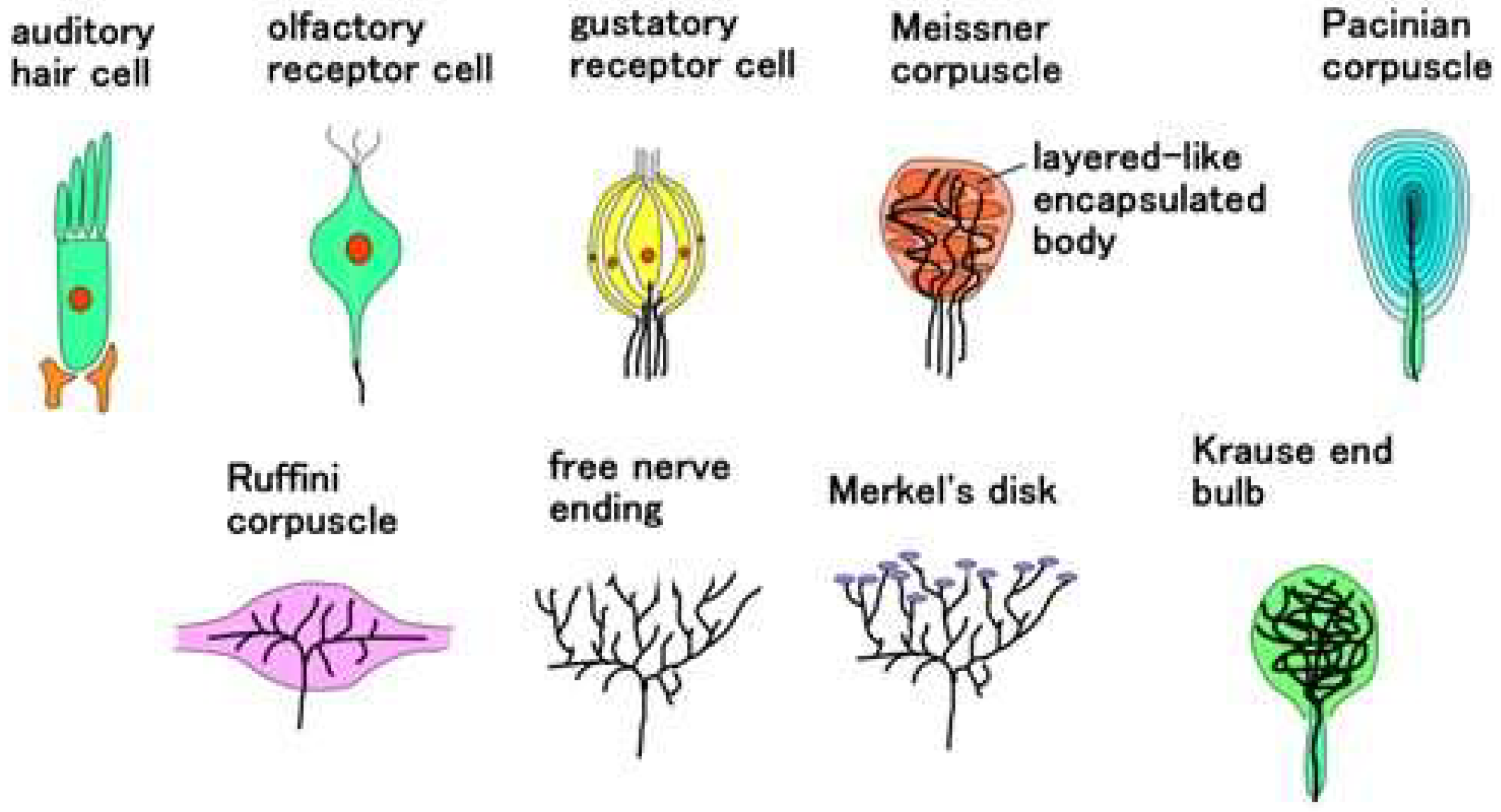



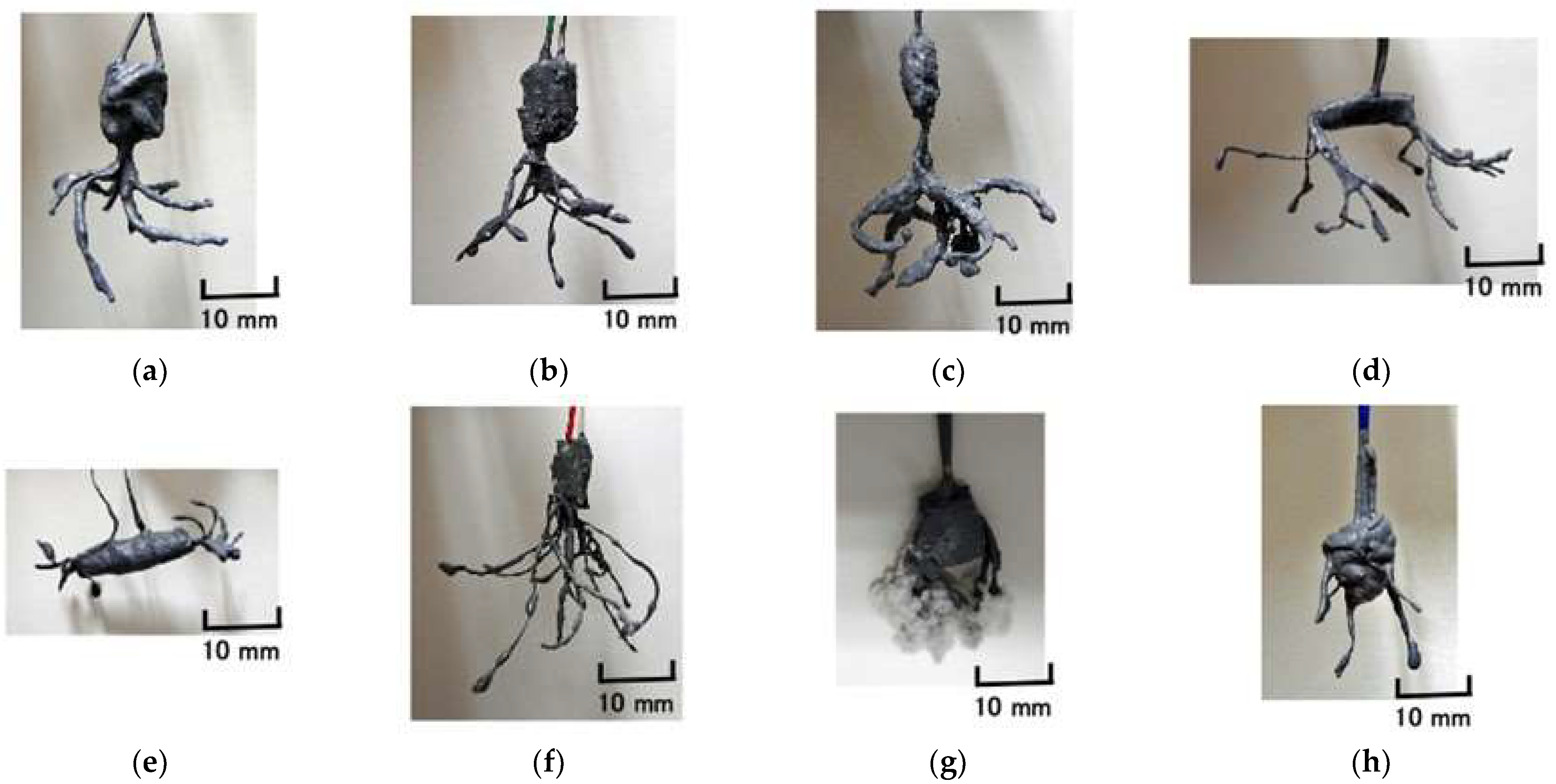
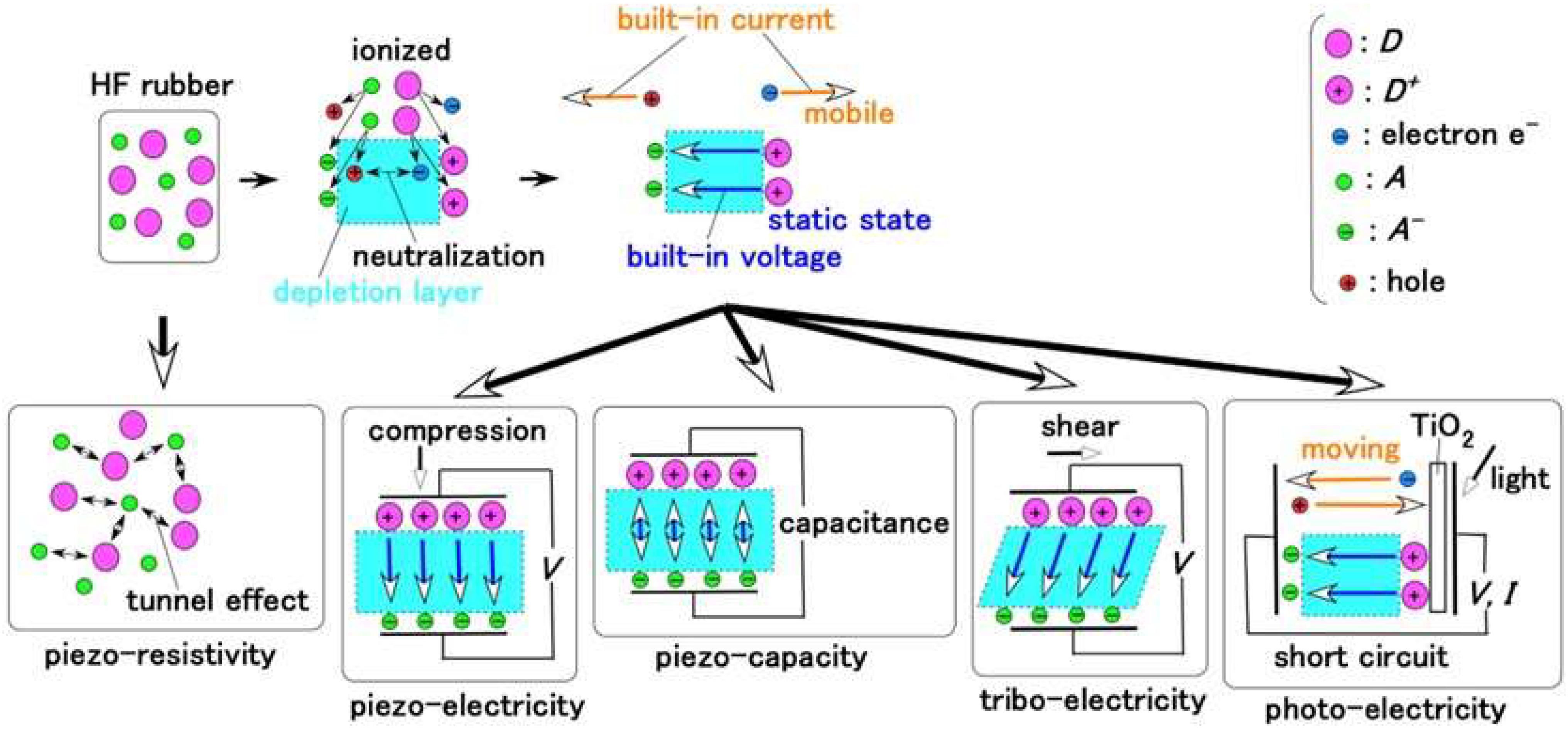
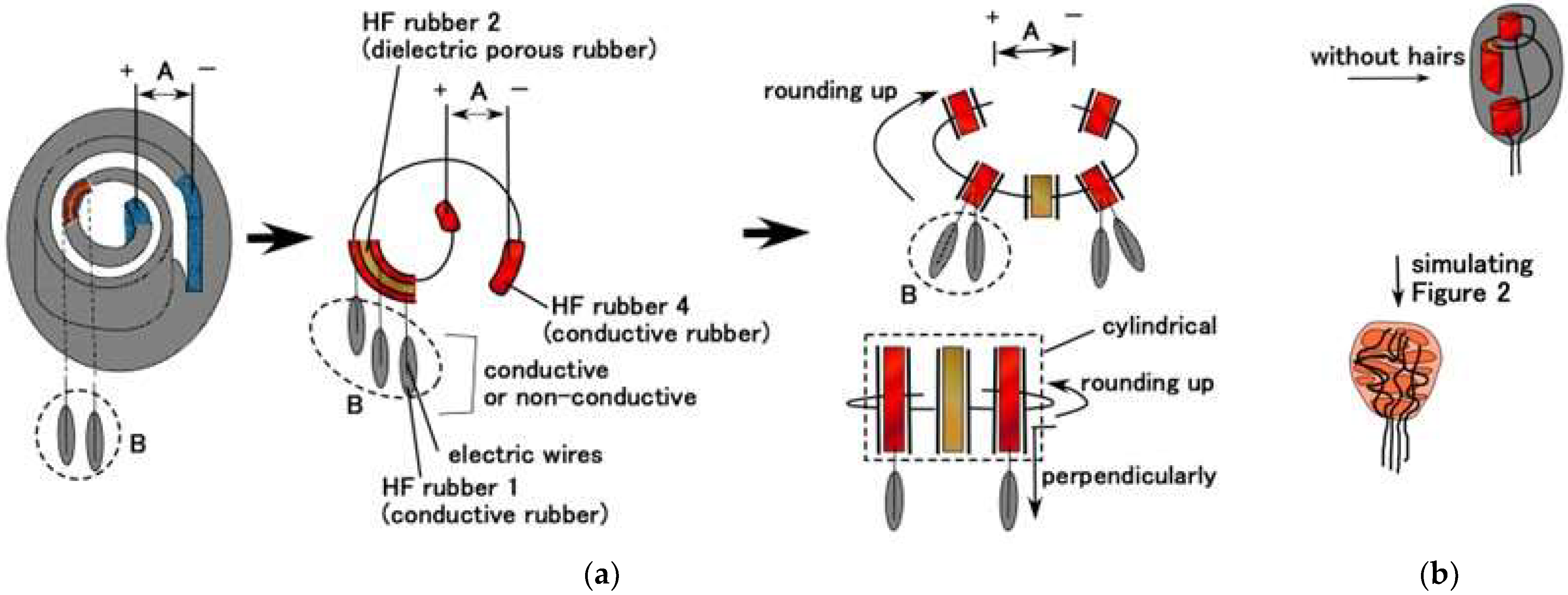

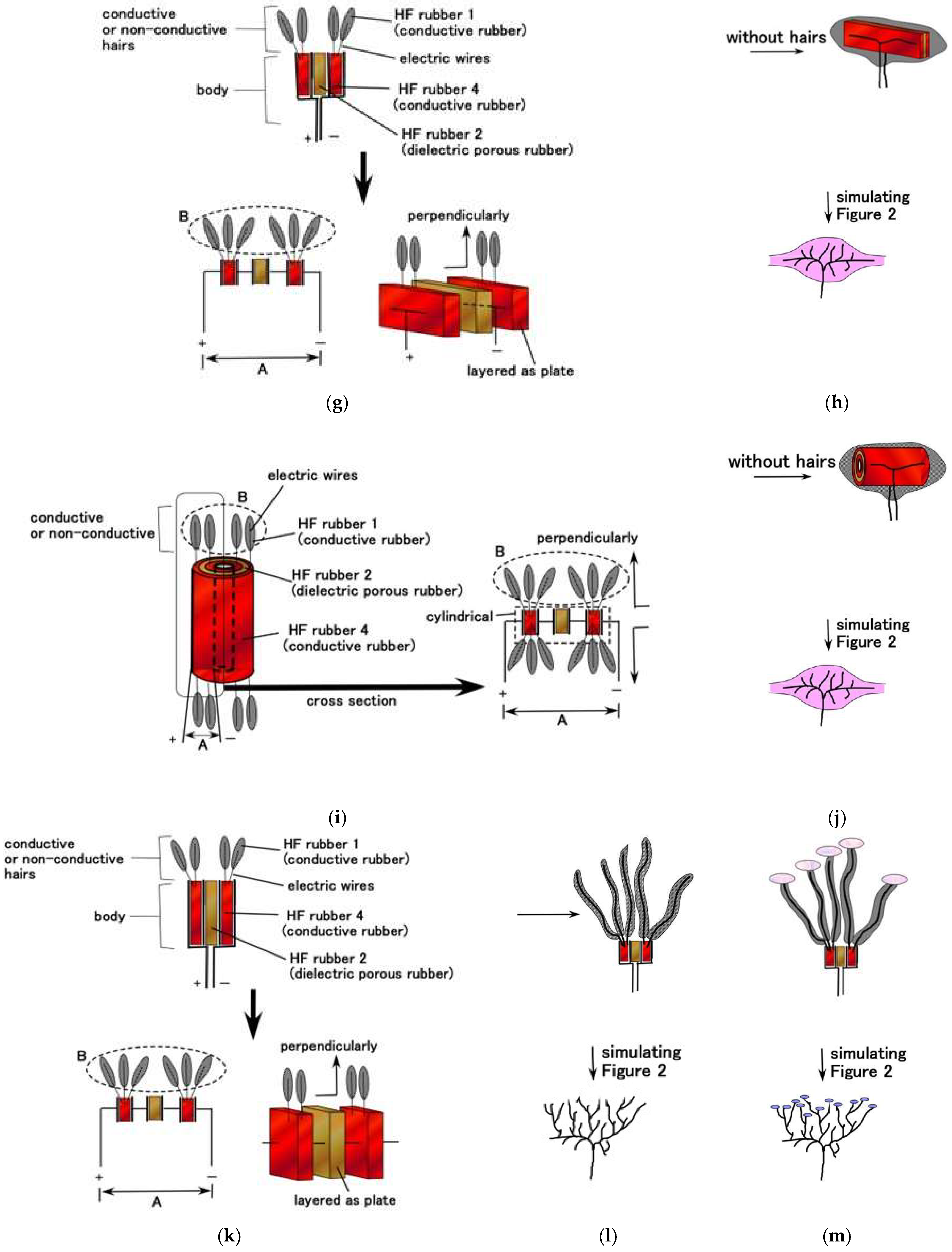
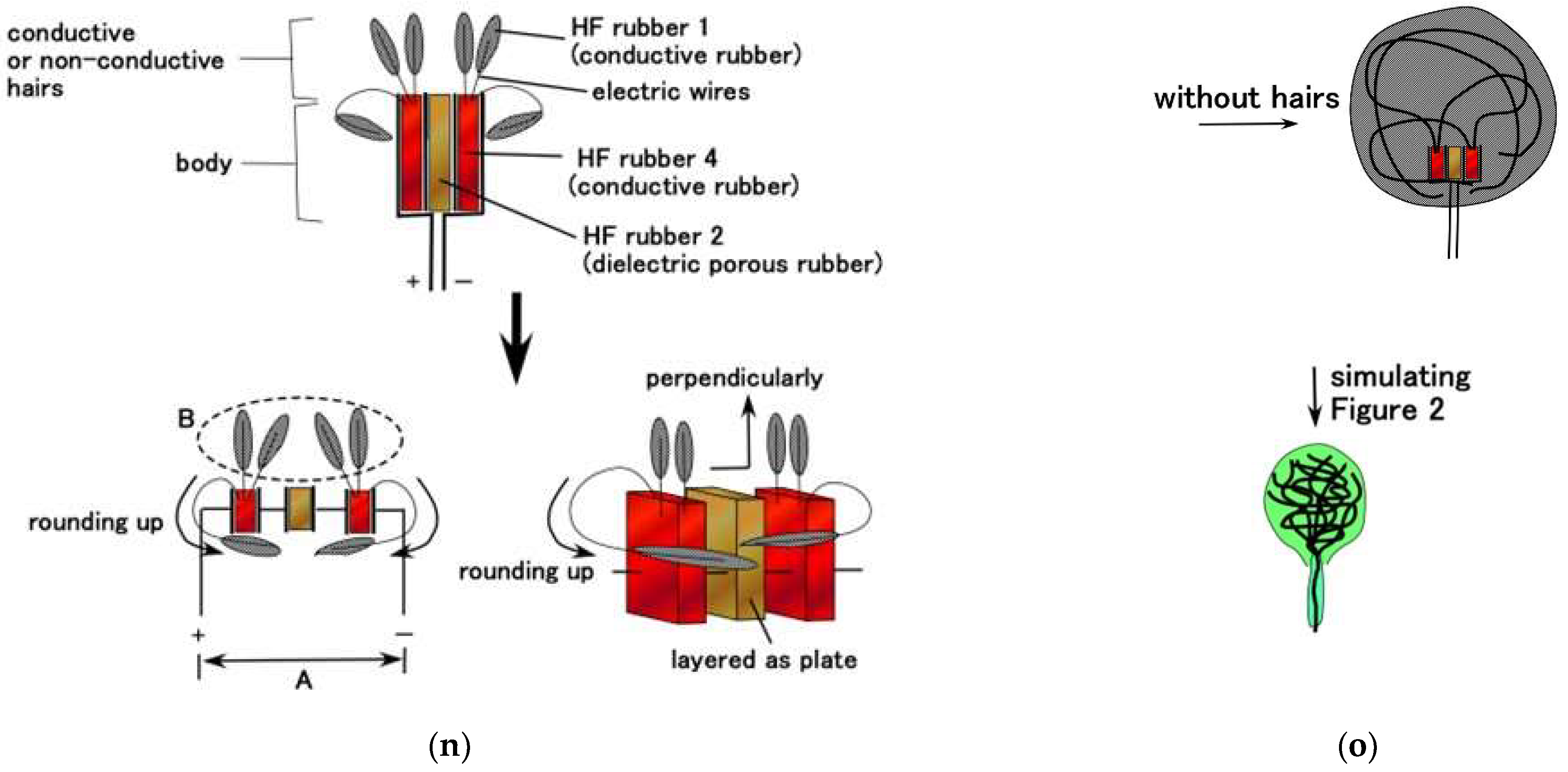








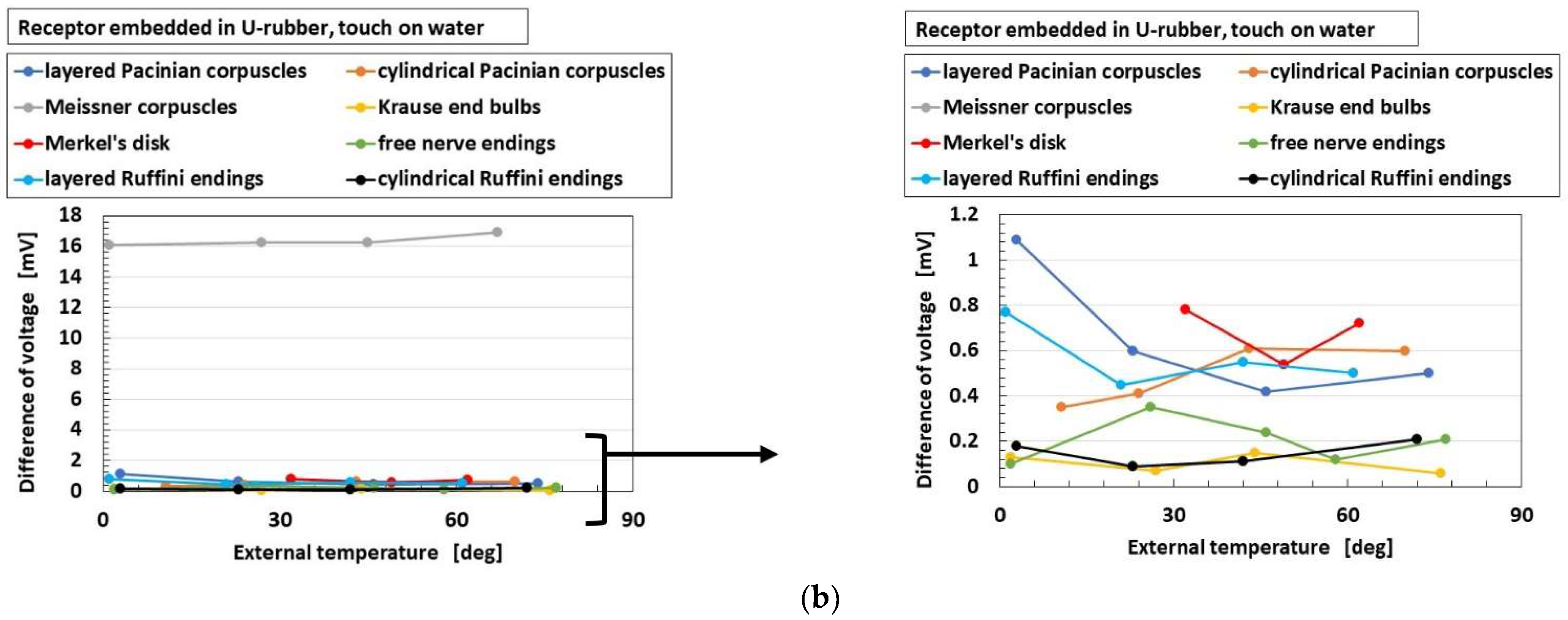





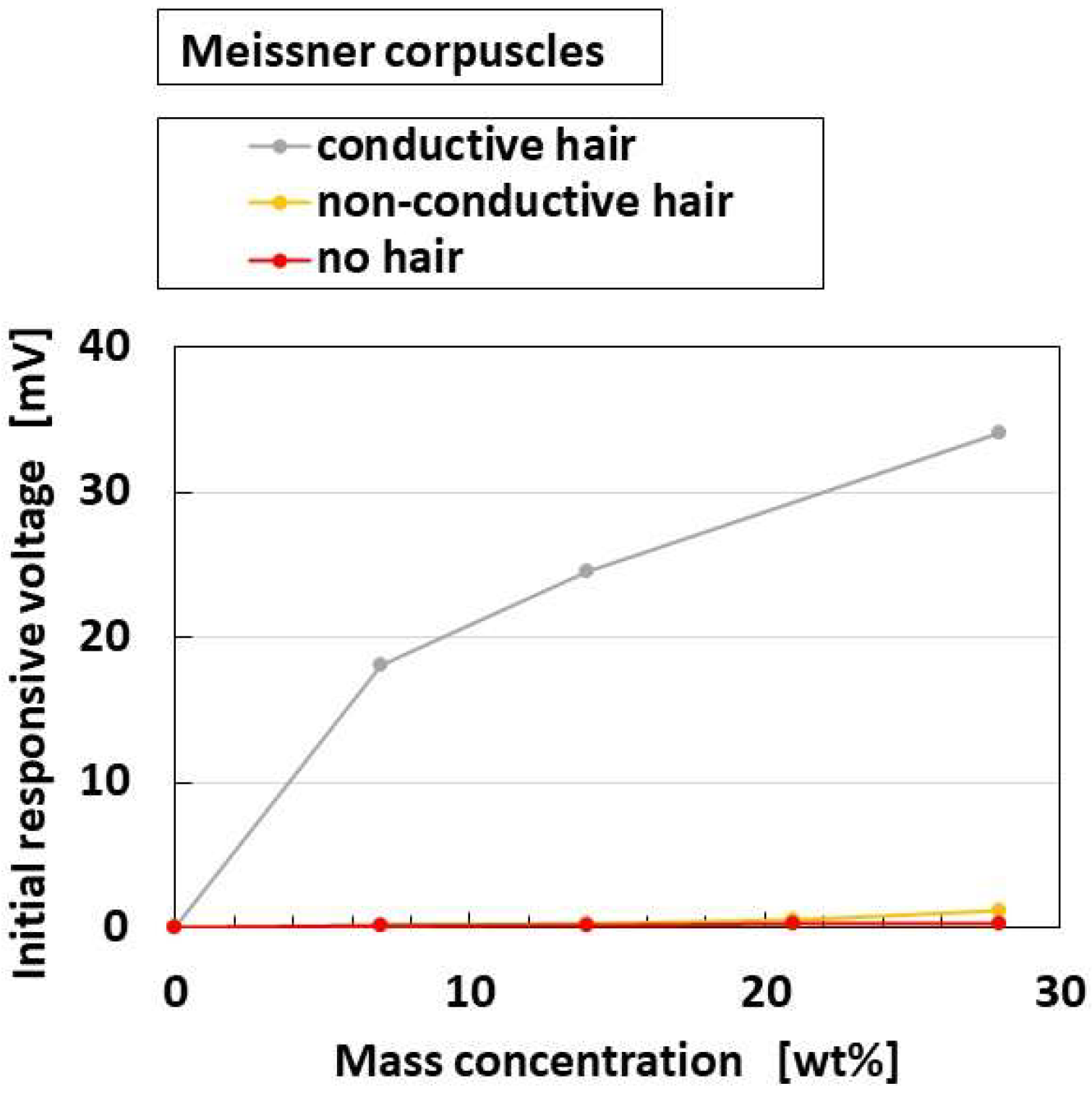

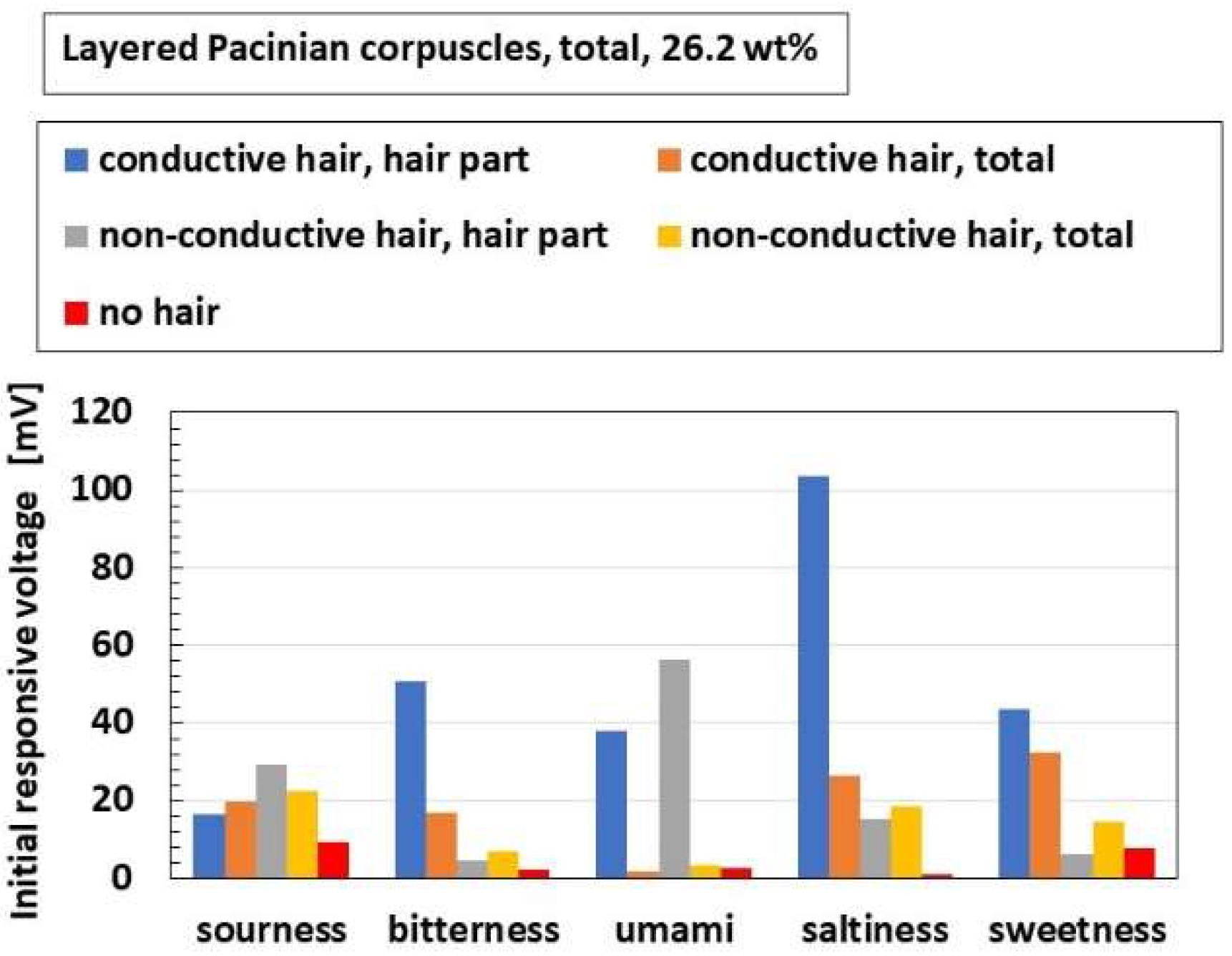

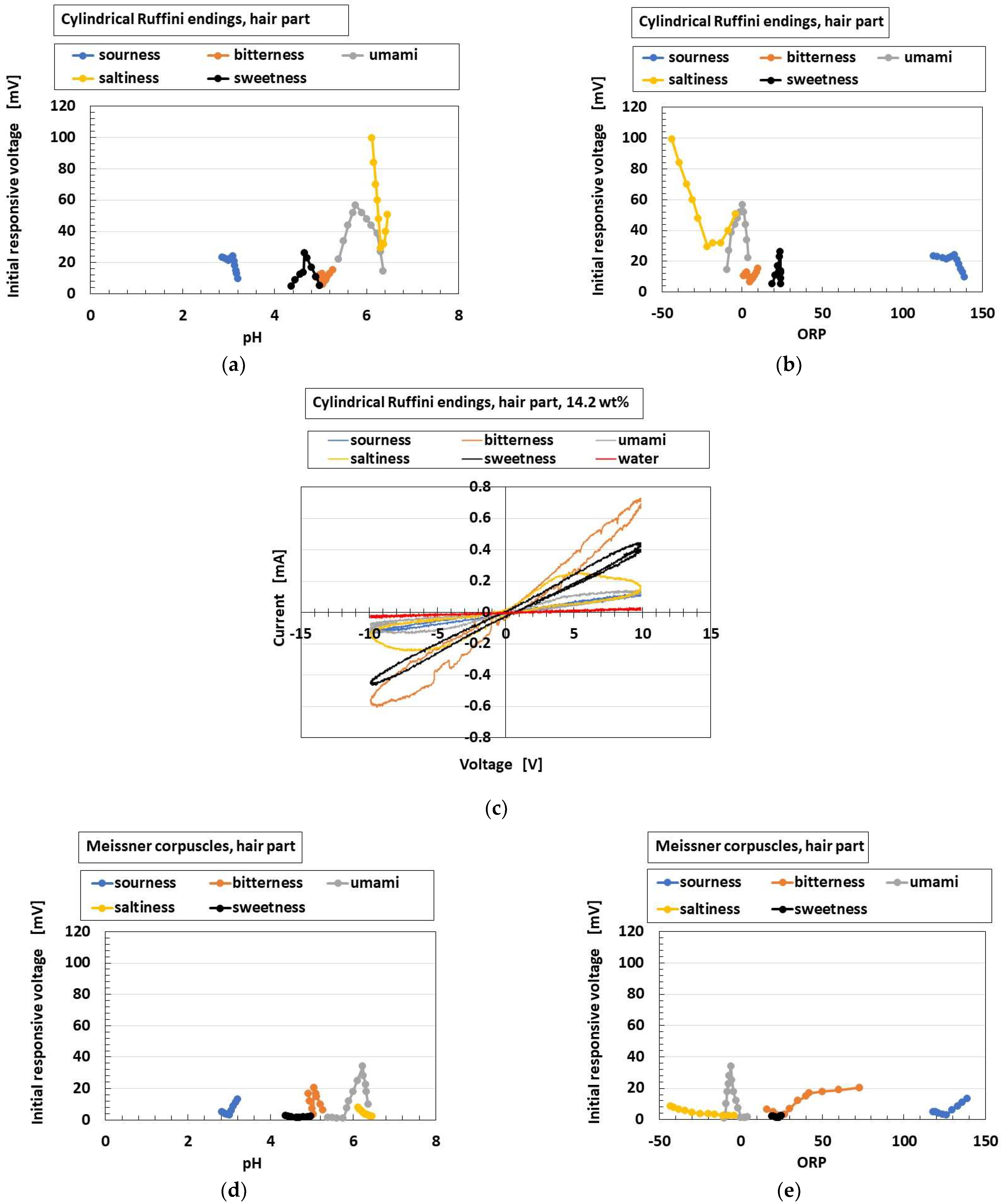

| Ingredients | HF Rubber 1 | HF Rubber 2 | HF Rubber 3 | HF Rubber 4 | |
|---|---|---|---|---|---|
| water | 3 g | 3 g | 1 g | 1 g | |
| sodium tungstate (VI) dehydrate (Na2WO4 2H2O, Fujifilm Wako Chemical Co., Ltd., Osaka, Japan) | 0.5 g | 0.5 g | - | 0.5 g | |
| TiO2 | 0.5 g | 0.5 g | 0.5 g | 0.5 g | |
| HF | 1 g | 1 g | 1 g | 1 g | |
| NR-latex (Ulacol; Rejitex Co., Ltd., Atsugi, Japan) | 3 g | 3 g | 3 g | 3 g | |
| CR-latex (671A; Showa Denko Co., Ltd., Tokyo, Japan) | 3 g | 3 g | 3 g | 3 g | |
| carbonyl Ni powder | 3 g | 3 g | 3 g | 3 g | |
| Sensation | Response | Receptor | ||||||||
|---|---|---|---|---|---|---|---|---|---|---|
| Layered Pacinian Corpuscles | Cylindrical Pacinian Corpuscles | Meissner Corpuscles | Krause End Bulbs | Merkel’s Disk | Free Nerve Endings | Layered Ruffini Endings | Cylindrical Ruffini Endings | |||
| force *1 | normal force *2 | mechanical | (pressure) | (pressure) | ⊚ | ◯ (pressure) | (indentation depth by pressing, sustained touch, pressure) | (touch) | (deep pressure) | (deep pressure) |
| shear force *3 | (dynamic deformation by shearing, changes in texture) | ◯ | ◯ (texture as fine touch) | (superficial touch) | ⊚ (stretch by skin) | (stretch by skin) | ||||
| vibration | low frequency | (70–1000 Hz) | ⊚ (70–1000 Hz) | ★ (slow vibration, 10–200 Hz) | ◯, ★ (0.4–100 Hz) | ★ | ★ (0.4–100 Hz) | ⊚ (0.4–100 Hz) | ||
| high frequency | ★ (high vibration) | ⊚, ★ (high vibration) | ⊚ (high vibration) | ★ | ◯ | ◯ | ||||
| auditory | ⊚ | ◯ | ◯ | ◯ | ⊚ (hair) | |||||
| temperature | cold | electric | ⊚ | ⊚ | (cold) | ◯ | (cold) | |||
| hot | ⊚ | ⊚ | ◯ | (heat) | (warmth) | (warmth) | ||||
| taste | chemical | ◯ | (mouth) | ◯ (tongue) | ⊚ | |||||
| smell | ⊚ | ⊚ | ◯ | ◯ | ||||||
Publisher’s Note: MDPI stays neutral with regard to jurisdictional claims in published maps and institutional affiliations. |
© 2022 by the author. Licensee MDPI, Basel, Switzerland. This article is an open access article distributed under the terms and conditions of the Creative Commons Attribution (CC BY) license (https://creativecommons.org/licenses/by/4.0/).
Share and Cite
Shimada, K. Morphological Configuration of Sensory Biomedical Receptors Based on Structures Integrated by Electric Circuits and Utilizing Magnetic-Responsive Hybrid Fluid (HF). Sensors 2022, 22, 9952. https://doi.org/10.3390/s22249952
Shimada K. Morphological Configuration of Sensory Biomedical Receptors Based on Structures Integrated by Electric Circuits and Utilizing Magnetic-Responsive Hybrid Fluid (HF). Sensors. 2022; 22(24):9952. https://doi.org/10.3390/s22249952
Chicago/Turabian StyleShimada, Kunio. 2022. "Morphological Configuration of Sensory Biomedical Receptors Based on Structures Integrated by Electric Circuits and Utilizing Magnetic-Responsive Hybrid Fluid (HF)" Sensors 22, no. 24: 9952. https://doi.org/10.3390/s22249952
APA StyleShimada, K. (2022). Morphological Configuration of Sensory Biomedical Receptors Based on Structures Integrated by Electric Circuits and Utilizing Magnetic-Responsive Hybrid Fluid (HF). Sensors, 22(24), 9952. https://doi.org/10.3390/s22249952






